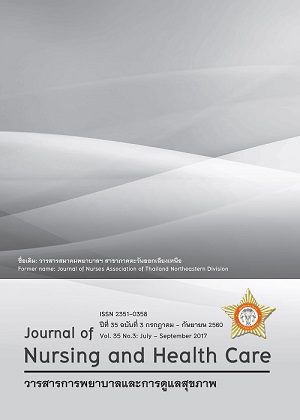ผลของโปรแกรมการป้องกันการพลัดตกหกล้มในผู้สูงอายุ Effects of Falling Prevention Program for Elderly
คำสำคัญ:
การพลัดตกหกล้ม โปรแกรมการป้องกันการพลัดตกหกล้ม ผู้สูงอายุ falling, falling prevention program, elderlyบทคัดย่อ
บทคัดย่อ
การพลัดตกหกล้มเป็นปัญหาสำคัญ ก่อให้เกิดผลกระทบต่อร่างกาย จิตใจ สังคม และเศรษฐกิจต่อตัวผู้สูงอายุและครอบครัว การวิจัยครั้งนี้เป็นการวิจัยเชิงทดลอง แบบสองกลุ่มคือวัดก่อนการทดลองและหลังการทดลอง เพื่อศึกษาผลของโปรแกรมการพลัดตกหกล้มในผู้สูงอายุ ในชุมชนตำบลนางแลอำเภอเมือง จังหวัดเชียงรายระหว่างเดือนสิงหาคม พ.ศ. 2559 ถึงเดือนกุมภาพันธ์ พ.ศ.2560 คัดเลือกกลุ่มตัวอย่างจากผู้สูงอายุที่มีคุณสมบัติตามที่กำหนดจำนวน 50 ราย สุ่มเข้ากลุ่มทดลองและกลุ่มควบคุม จำนวน 25 ราย กลุ่มทดลองได้รับโปรแกรมการป้องกันการพลัดตกหกล้มจำนวน 7 สัปดาห์ ๆ ละ 1 ครั้ง ๆ ละ 1 ชั่วโมง 30 นาที กลุ่มควบคุมดูแลตนเองตามปกติ การเก็บรวบรวมข้อมูลประกอบด้วย แบบบันทึกข้อมูลทั่วไป โปรแกรมการป้องกันการพลัดตกหกล้มแบบประเมินความรู้และพฤติกรรมการป้องกันการพลัดตกหกล้มที่ผู้วิจัยพัฒนาขึ้น นำมาหาความเที่ยงหาค่าความความตรงและความเชื่อมั่นของเนื้อหาเท่ากับ .85และ .87และแบบบันทึกการพลักตกหกล้ม วิเคราะห์ข้อมูลโดยใช้สถิติพรรณนา สถิติทดสอบค่าที
ผลการวิจัยพบว่าหลังได้รับโปรแกรมการป้องกันการพลัดตกหกล้ม ผู้สูงอายุมีความรู้และพฤติกรรมดีกว่าก่อนได้รับโปรแกรมอย่างมีนัยสำคัญทางสถิติ (p < .001) ผู้สูงอายุที่ได้รับโปรแกรมมีความรู้และพฤติกรรมการป้องกันการพลัดตกหกล้มดีกว่ากลุ่มที่ไม่ได้รับโปรแกรม อย่างมีนัยสำคัญทางสถิติ (p < .001) และอัตราการพลัดตกหกล้มของกลุ่มที่ได้รับโปรแกรมการป้องกันการพลัดตกหกล้ม(x̄ = 1.3, S.D. = 0.48) ภายใน 90 วัน ต่ำกว่ากลุ่มที่ไม่ได้รับโปรแกรม(x̄ = 1.4, S.D. = 0.50)
Abstract
Falls are the leading cause of injury frequently found in the elderly. This two group pretest-posttest experimental research aimed to investigate the effects of falling prevention program for elderly at Tambon Nang Lae, AmphoeMuang Chiang Rai during October, 2016 – December, 2017. The sample included 50 elderly participants randomly selected from those who met the inclusion criteria. The participants were randomly assigned equally into experimental and control groups in 25 participants in each group. The experimental group underwent 7-week falling prevention program with 1.5 hours weekly activities. The control group receivedno particular program expert their own self care. Data were collected using Personal Data Recording form, Falling Prevention Program, Assessment of knowledge and behavior to prevent falls Questionnaire that were specially developed where its validity and reliabilitywere .85 and .87 respectively and Falling Recording Form. Data were analyzed using descriptive statistics and t – test.
The result of this study revealed that, after receiving falling prevention program knowledge and behavior regarding fall prevention were significantly higher than thoseusing usual self care. The elderly receiving falling prevention program had better falling prevention behaviors than those using usual self care (p < .001) and the falling rate in 90 days for those receiving falling prevention program(x̄ = 1.3, S.D. = 0.48 were decreased(x̄ = 1.4, S.D. = 0.50) .


